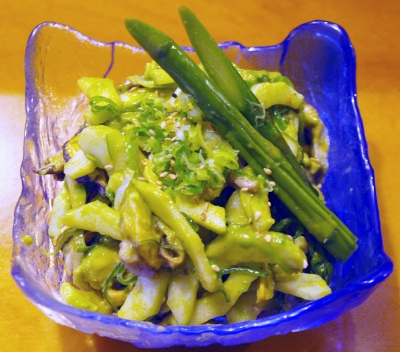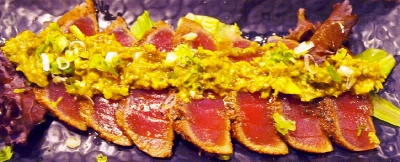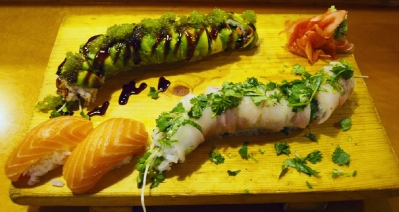
Tuesday, July 20. Kyoto. Went into town early to write the check to Amtrak for the Eat Club's Chicago trip. You have to actually go to the station to do this. I gave myself an extra forty-five minutes for that. It wasn't enough. The reservations clerk admitted that he handled groups so seldom he didn't remember exactly how to fill out the form, took all that time to fill out two forms in sextuplicate--all by hand. The computer wasn't down; this was the normal way Amtrak does group tickets. They also wanted to know about the Eat Club, and what it was like to be on the radio. Nice guys. But if I hadn't rushed them up I would have been late getting on the air.
I get nervous when I write a check for five figures. Especially when what I get in return for it is a pair of handwritten forms in an envelope, plus the advice that if I lose it, there can be no refund.
I parked in front of Kyoto last week when I had dinner at La Thai Cuisine. The sight of the restaurant told me, "You haven't been here in a long time!" I haven't. So I called my little sister Lynn--a sushi buff--and asked whether I might treat her to a sampling of the food.
Sushi restaurants come in two packages. There's the sleek, lacquered, modern, glass-and-stainless-steel kind. And there are the restaurants that adapt to the space they find and can afford. The latter is usually in need of a renovation, with the sushi bar grabbing the biggest space, and everything else wedged in wherever it fits. If the architectural dichotomy is any indicator of how good the food will be, I'd say that places with the shoehorned-in look are noticeably better. At least here in New Orleans.
On the other hand, a contra-indicator was stuck to the window in the door. Kyoto, it said, would close for vacation in two or three days. I had to stop and think of the date to make sure this wasn't the very last night before the break. The last place you want to dine is in a restaurant on the verge of taking time off. Or--probably worse--one that has just returned.

Lynn was there at the sushi bar when I arrived. We took an inordinately long time--almost long enough to kill an entire initial round of Asahi--to figure out what to get. Finally, we placed an order for tuna tataki, a wild mushroom salad, salmon nigiri, and two big specialty rolls. The latter was the cause of delay. Step one in ordering specialty rolls is reading the entire list to find the few that do not contain crabstick or crab salad.

The soup came first, followed by the tuna tataki and the salad. I love tuna tataki. And its beef counterpart, too. It's essentially raw, but seared around the edge of each half-dollar-thick slice. This is a fine point. The chef can take the easy way out and put the fish on a just-hot grill, checking it every now and then while he works on something else. Or, if you're lucky, he can really blast it, for just a few seconds at a time, until the exterior is crunchy. The hard, thin rind then goes no deeper than the slice is thick. From the crustopause* on in, the fish is ice-cold. Splashes of ponzu add piquancy.
The wild mushroom salad was a surprise. This appeared to be more a cucumber salad than mushrooms, but you could surely taste the latter, mellow and woodsy, with an almost resinous finish. I liked this better than Lynn did.

The rolls were good and very filling. Maybe that's what they mean by the name "slow-ya" roll. Except for the tobiko, this was a vegetarian job, loaded with avocado. Loved it. The other was a ceviche roll, the fish marinated in citrus juice and covered with cilantro. Very refreshing. The basic salmon nigiri sushi is something I always order, so I can get a good look at the moisture and temperature of the rice and fish, without sauces and garnishes distorting things. I'd give this sample and eight on a scale of ten.
Lynn and I got into a discussion of my many nerdy fields of interest. I made the mistake of telling her that, after forty years of wondering, I'd figured out the mechanics of accordion-fold bus doors in GMC models older than around 1954. When these open and close, they do so with a unique motion, one too subtle for me to explain. I first noticed this when I was a little kid. The rhythm of the bus door has, for reasons I'm at a loss to explain, remained in the front row of my consciousness to this day. Streetcar doors have the same motion, but open so slowly that the subtlety is largely lost.
After I explained all that, Lynn must have thought (I'm sure not for the first time) that I might be a little too eccentric.
![]()
![]()
![]() Kyoto. Uptown: 4920 Prytania. 504-891-3644. Japanese.
Kyoto. Uptown: 4920 Prytania. 504-891-3644. Japanese.
*crustopause, n.--The line at which the hard, crunchy exterior of a seared meat or seafood meets the soft, juicy interior. I just made up this word. It's one I think we need.